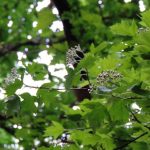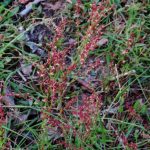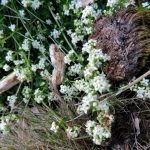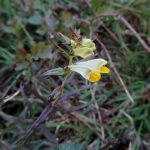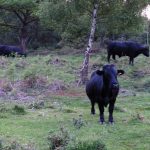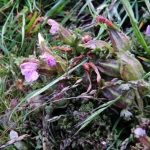On the evening of 28th May eleven members and friends set off for a memorable walk through Silchester Common, expertly led by Graham Saunders. Despite the fact that thunderstorms had been predicted, the skies were clear and during the walk we saw a beautiful sunset over the heathland.
Graham first took us to the woods adjacent to the Common to show us the rare Wild Service Tree (Sorbus torminalis), full of flowering buds. We also saw Greater Stitchwort (Stellaria holostea) here. Then we went onto the heath where recently a large area had been cleared from invading gorse. This may enhance the birdlife and ground-covering flora. Plants we saw in the cleared area included Sheep’s Sorrel (Rumex acetosella), Foxglove (Digitalis purpurea), Bracken (Pteridium aquilinum), Early Hair-grass (Aira praecox, abundant), Field Wood-rush (Luzula campestris), Toad Rush (Juncus bufonius), Tormentil (Potentilla erecta), Heath Milkwort (Polygala serpyllifolia), Heath Speedwell (Veronica officinalis), Heath Bedstraw (Galium saxatile), Lesser Stitchwort (Stellaria graminea), Slender Trefoil (Trifolium micranthum), Germander Speedwell (Veronica chamaedrys), Sticky Mouse-ear (Cerastium glomeratum, in fruit), Pill Sedge (Carex pilulifera), Wood Sage (Teucrium scorodonia, not yet in flower), Wavy Hair-grass (Deschampsia flexuosa), Heather (Calluna vulgaris) bushes, the semi-parasitic Common Cow-wheat (Melampyrum pratense) and Green-ribbed Sedge (Carex binervis). We heard the screeching noises of Jays (Garrulus glandarius) and the songs of a Willow Warbler (Phylloscopis trochilus) and Chiffchaff (P. collybita).
We then entered the denser area where the Gorse (Ulex europaea) had been left. Here we saw Honeysuckle (Lonicera periclymenum) climbing over the bushes, not yet in flower, Wall Speedwell (Veronica arvensis), Herb-Robert (Geranium robertianum), Sweet Vernal-grass (Anthoxanthum odoratum), Wood Anemone (Anemone nemorosa, leaves only), Holly (Ilex aquifolium), Thyme-leaved Speedwell (Veronica serpyllifolia), Mouse-ear-hawkweed (Pilosella officinarum), Lousewort (Pedicularis sylvatica) and Squirrel-tail Fescue (Vulpia bromoides).
A board walk led us into a swampy area. Young red-brown and black cows and bullocks were grazing here. Plants included Lesser Spearwort (Ranunculus flammula), Marsh St John’s-wort (Hypericum elodes), Star Sedge (Carex echinata) and Bog Pondweed (Potamogeton polygonifolius). Further along the path we found a dead Common Shrew (Sorex araneus). When it was getting darker, two Woodcocks (Scolopax rusticola) flew over. A Song Thrush (Turdus philomelos) was singing loudly. When this bird stopped singing, we heard a Tawny Owl (Strix aluco) and soon afterwards the sound we hoped to hear, the call of the Nightjar (Caprimulgus europaeus), very close by and going on for a long time. We all stopped talking and listened to the bird, a magical moment. Several people of the group recorded the sound. After a while the call was repeated and we saw a Nightjar flying over. When the Song Thrush started singing again, it was imitating the call of the owl and flight call of the Nightjar.
Audio PlayerKen White’s recording of a Nightjar
It was nearly dark when we returned, stopping near a pond where we saw bats flying. Graham switched on his bat-recorder and at two different frequencies bats could be heard, at 45 kHz the Common Pipistrelle, Pipistrellus pipistrellus, and at 50 kHz the Soprano Pipistrelle, P. pygmaeus. It had been a wonderful trip!
Report by Renée Grayer
Pictures by Rob Stallard

